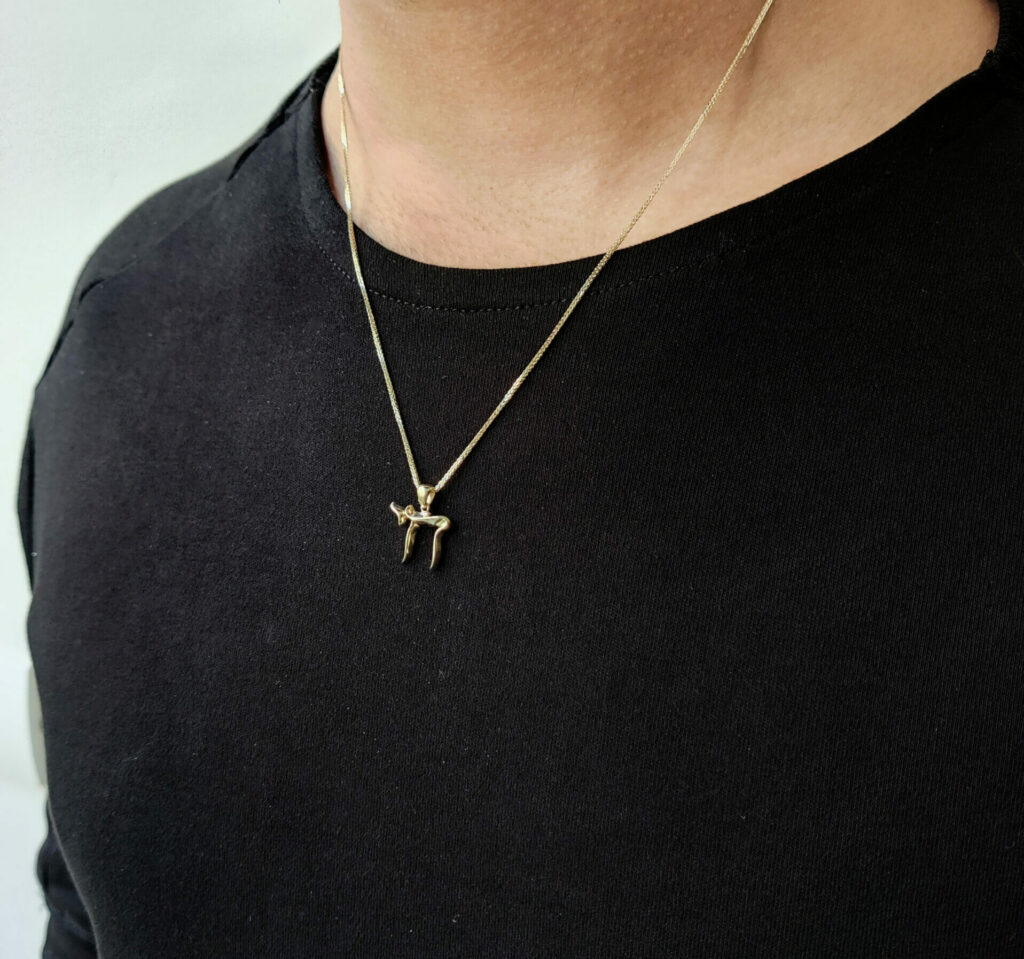
This explains why the idea of jewelry is ancient, going back much further than recorded history. According to archaeological discoveries in ancient caves, prehistoric predecessors made gems over 100,000 years ago. These early ornaments were more functional and had materials made from animal bones, stones, and wood.
You can always find Jewish faith, heritage, and pride in any of the innumerable amulets, kabbalistic ornaments, wedding rings, bracelets, or symbols such as the chosen Mezuzah, Star of David, Hamsa, and Chai, to mention a few. Jewish jewelry also denotes protection, love, prosperity, and even Jerusalem.
All these beg the question of where Jewish jewelry finds its roots. What is the origin of Jewish jewelry? What is Jewish jewelry’s history?
Read on as this article delves into Jewish jewelry history and other valuable information surrounding it.
To hear the entire article for your convenience, click the play button.
Ancient Jewish Jewelry
1. Choshen
God instructed Aaron, Moses’ brother and the father of the high priests, to put on the “Choshen” before entering the temple. The twelve diamonds on the Choshen, a clerical breastplate, stood for the twelve tribes of Israel. It acted as a reminder of God and the grandeur of the temple and a bridge between God and the world of man during difficult times.
What are the 12 precious stones in the Jewish Bible?
2. Star of David Jewelry

In fact, the Star of David was not widely used as a Jewish symbol until the 17th century. It was then that the Jewish community of Prague adopted the symbol as their official seal. From there, the Star of David gradually became more widely accepted as a symbol of Judaism. Today, it is one of the most recognizable symbols of Judaism in the world.
Star of David Jewelry is a shining symbol of faith, identity, and heritage. This sacred emblem holds deep meaning for those who embrace the Jewish faith and serves as a beautiful reminder of their connection to their roots.
Wearing Star of David Jewelry is more than just adorning oneself with a stunning accessory – it is an expression of pride and closeness to one’s beliefs. Each piece tells a story, carrying with it the rich history and traditions that have been passed down through generations.
3. Chai Jewelry

The idea of Chai is the foundation of numerous Jewish customs, including offering presents in multiples of 18. The word “chai” is rooted in medieval Spain, and wearing it as a lucky charm or protective amulet dates back to Eastern Europe in the 18th century.
Indulge in the beauty of Chai Jewelry and let it become an extension of your spirit. Elevate your fashion game while embracing tradition and spirituality in one breathtaking piece. It’s time to let your inner radiance shine through with Chai Jewelry!
4. Mezuzah Jewelry
Welcome to the exciting world of Mezuzah Jewelry! If you’re looking for a stylish and meaningful accessory, then you’ve come to the right place. Mezuzah jewelry is not just about fashion – it carries deep spiritual significance.
Mezuzahs are traditional Jewish symbols that are commonly placed on doorways in Jewish homes. They contain religious texts on parchment and serve as a reminder of faith and protection. Now, imagine wearing this powerful symbol in the form of beautiful jewelry!
Mezuzah necklaces, bracelets, and earrings are designed with exquisite craftsmanship to capture both elegance and spirituality. Whether you’re looking for a dainty pendant or a statement piece, there’s something for everyone in the world of Mezuzah jewelry.
Not only does Mezuzah jewelry add a touch of sophistication to any outfit, but it also serves as a constant reminder of your beliefs and values. It can be worn as an expression of faith or as an elegant accessory that sparks meaningful conversations.
So, if you’re ready to embrace both style and spirituality, join us on this mesmerizing journey into the world of Mezuzah Jewelry. Discover unique designs that represent tradition, love, and connection – all wrapped up in one stunning piece.
5. Hamsa Jewelry

Discover the captivating allure of Hamsa Jewelry, a symbol steeped in ancient tradition and timeless beauty. Hamsa, also known as the Hand of Fatima or Hand of Miriam, is a powerful talisman believed to offer protection against negative energies and bring blessings into one’s life.
This enchanting piece of jewelry features a stylized hand with an eye in the center, representing wisdom and insight. Crafted with intricate details and meaningful symbolism, Hamsa Jewelry serves as a reminder to stay grounded and connected to our inner strength.
Wearing Hamsa Jewelry is not just about accessorizing; it signifies a deeper connection to spirituality and self-expression. It can be seen as a form of personal affirmation – a visual representation of one’s beliefs and values.
The versatile nature of Hamsa Jewelry allows it to be worn by people from different cultures and backgrounds, transcending boundaries. Whether it’s an elegant pendant, a delicate bracelet, or a statement ring, each piece carries its own unique energy, adding an element of mystique to any ensemble.
Embrace the power of this ancient symbol. Let Hamsa Jewelry serve as inspiration in your daily life – reminding you to embrace positivity, protect your inner peace, and radiate love into the world around you. Unlock the transformative energy that lies within Hamsa Jewelry and empower yourself with its captivating charm.
Click here to explore our entire collection of Hamsa Jewelry.
Jewelry in Biblical Times
The Jewish people have a long history of wearing jewelry. Biblical passages, such as those found in Genesis, Exodus, and Hosea, discuss how jewelry, especially among women, was used to attract attention and entice people.
In Isaiah 61:10 in the Bible, there are notes that the bride and groom will require jewelry on a particular day. People should rejoice since God has sacrificed and saved us. There are expectations for women to be simple in Chapter 1 of Timothy 2:9. They are also likely to braid their hair and wear expensive pearls or gold jewelry on their wedding day.
According to the Bible, ladies used to dress in priceless jewelry and ornaments, particularly for their wedding day. They can demonstrate their strength and greatness differently by doing this to their long-term partner and his family. Additionally, it implies that you shouldn’t regard them lightly because they are strong.
To see our entire collection of Jerusalem jewelry.
Sephardic and Ashkenazi Jewelry
● Sephardic Jewelry
Spanish Jews are known as Sephardic Jews because Sepharad is the Arabic word for Spain. They expanded throughout the Middle East, North Africa, and the Mediterranean. Jewelry made by Sephardic people frequently features elaborate designs inspired by the vibrant artistic traditions of the areas where Sephardic populations once flourished.
Sephardic Jewelry has numerous designs from the Hamsa, Filigree, and Pomegranate. Exquisite filigree work, in which thin wires of gold or silver are wrapped around each other and soldered together to produce complex patterns and designs, is a common aspect of Sephardic jewelry.
The Pomegranate is a vital emblem of fertility, surplus, and success in Sephardic culture. Jewelry frequently uses carvings or jewels to represent it.
● Ashkenazi Jewelry

Ashkenazi jewelry commonly features the Star of David, designed with Hebrew inscriptions and gemstones. Many often inscribe religious words or blessings in Hebrew on Ashkenazi jewelry. You can find these writings on jewelry like rings, pendants, and amulets. In addition, precious stones like diamonds, rubies, and emeralds are frequently used in Ashkenazi jewelry to give the pieces a sense of sophistication and wealth.
Contemporary Jewish Jewelry

Welcome to the vibrant world of contemporary Jewish jewelry! These stunning pieces showcase the rich cultural heritage and artistic expression of the Jewish community. From delicate pendants adorned with symbols like the Star of David to intricate hamsa hand earrings, this unique form of jewelry encapsulates history, spirituality, and modern design.
Contemporary Jewish jewelry combines traditional motifs with innovative materials and techniques, resulting in breathtaking pieces that resonate with individuals from all walks of life. Each creation tells a story, whether it’s celebrating Jewish customs, expressing personal faith, or simply embracing the beauty and intricacy of this art form.
Jewish jewelry is a trendy choice for birthday, and bat mitzvah presents. Spiritual Kabbalah jewelry is becoming increasingly popular and is made from occult symbols and patterns. The iconic red ribbon, the evil eye, and the “Tree of Life” are some of the most well-known symbols utilized in Kabbalah jewelry.

Hebrew name jewelry is another fantastic form of contemporary Jewish jewelry that links and expresses Jewish pride and tradition. Jewelry made in Jerusalem reflects our shared appreciation of this fantastic place and its rich history.
The inclusion of Roman Glass, which presents an eye-catching blend of yellows, blues, and pinks that creates a unique and one-of-a-kind piece of jewelry, represents one of the current developments in Jewish jewelry. The glass develops its hues due to a chemical process involving glass, earth, and air after 2,000 years of subterranean repose.
Check here for unique products in the Diamonds Jewish jewelry category.
Yemenite Silversmithing
In antiquity, Jewish settlers in Yemen and other southern Arabian Peninsula countries were the origin of Yemenite silversmithing. Over many years, these craftspeople perfected their skills, finding influence in their environment, indigenous customs, and Jewish religious practices. Throughout the 17th and 19th centuries, when Yemenite Jewish communities were at their zenith, Yemenite silversmithing saw an era of splendor during the Islamic Golden Age.
Yemenite Filigree Jewelry
What is Yemenite Jewelry?

Yemenite Filigree Jewelry holds a rich cultural and historical significance. Originating from Yemen, this intricate art form showcases the skilled craftsmanship of Yemeni jewelry makers.
Filigree is a delicate metalwork technique that involves shaping thin strands or wires of precious metals, such as silver or gold, into intricate patterns and designs. The result is a breathtaking piece of jewelry that embodies the cultural heritage and artistic traditions of Yemen.
Yemenite Filigree Jewelry is known for its intricate patterns, elaborate motifs, and meticulous attention to detail. These pieces often feature geometric shapes, floral designs, and symbols that hold deep cultural meanings. Each piece is meticulously handcrafted by skilled artisans who have mastered the art of filigree over generations.
What is the History of Jewelry in Yemen?
The history of Yemenite Filigree Jewelry dates back centuries, with influences from various cultures such as Egypt, Persia, and Europe. It serves as an important cultural symbol reflecting the diversity and beauty of Yemeni heritage.
Whether it’s a pair of delicate earrings, an intricately designed pendant, or an exquisite bracelet, Yemenite Filigree Jewelry captivates with its elegance and timeless appeal. Admired for its craftsmanship and uniqueness, these pieces are treasured heirlooms passed down through generations.
In today’s global market, Yemenite Filigree Jewelry continues to gain recognition for its artistic value and distinct charm. Its popularity has extended beyond Yemen’s borders as people around the world appreciate the beauty and craftsmanship behind each piece.
With every handmade creation infused with history and tradition,Yemenite Filigree Jewelry serves as a reminder of the rich cultural heritage it represents while showcasing the remarkable skills possessed by its artisans.
Explore our stunning collection of intricately crafted Jewish Filigree Jewelry.

Conclusion
Since the time of the Bible and far into our own, Jews have used jewelry as a vital means of demonstrating reverence and faith while asking for divine protection. It’s no wonder many entwine Judaica’s symbolism and iconography with Jewish cultural norms and values. They play a vital role in essential rituals as a link between the divine and human worlds and as a vehicle for expressing love, comradeship, and spirituality.
















